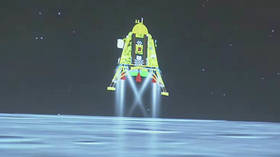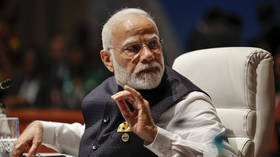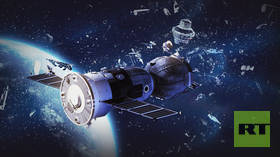‘India is a superpower!’ How the most populous country on Earth reacted to the success of its historic Moon mission
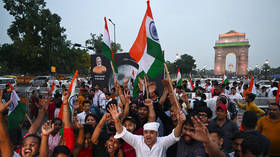
Bengaluru: It was an ‘Over the Moon’ moment for all Indians when the nation’s third lunar probe, Chandrayaan-3, made history, touching down in the South Pole region of Earth’s nearest cosmic neighbor with clockwork precision on Wednesday evening.
The Moon landing set off celebrations across the country of 1.4 billion people: fireworks, dances, distribution of sweets and the sound of slogans like “India is a superpower!”
In Bengaluru, the home of the Indian Space Research Organisation (ISRO), school and college students waved the Indian tricolor high in the air while staffers returning home from work stopped to stare at the Moon, their smiles from ear to ear. Some others posed for pictures with cut-outs and models of Chandrayaan-3 and the GSLV rocket.
Prime Minister Narendra Modi, who witnessed the historic moment from Johannesburg, South Africa, where he is attending the BRICS summit, remarked about the historic feat while addressing Team ISRO: “This moment is unforgettable, unprecedented. This moment is the victory cry of a developed India. This moment is the triumph of the new India. This moment signifies new energy, belief, and consciousness in India. This moment is the call of India’s ascending destiny.”
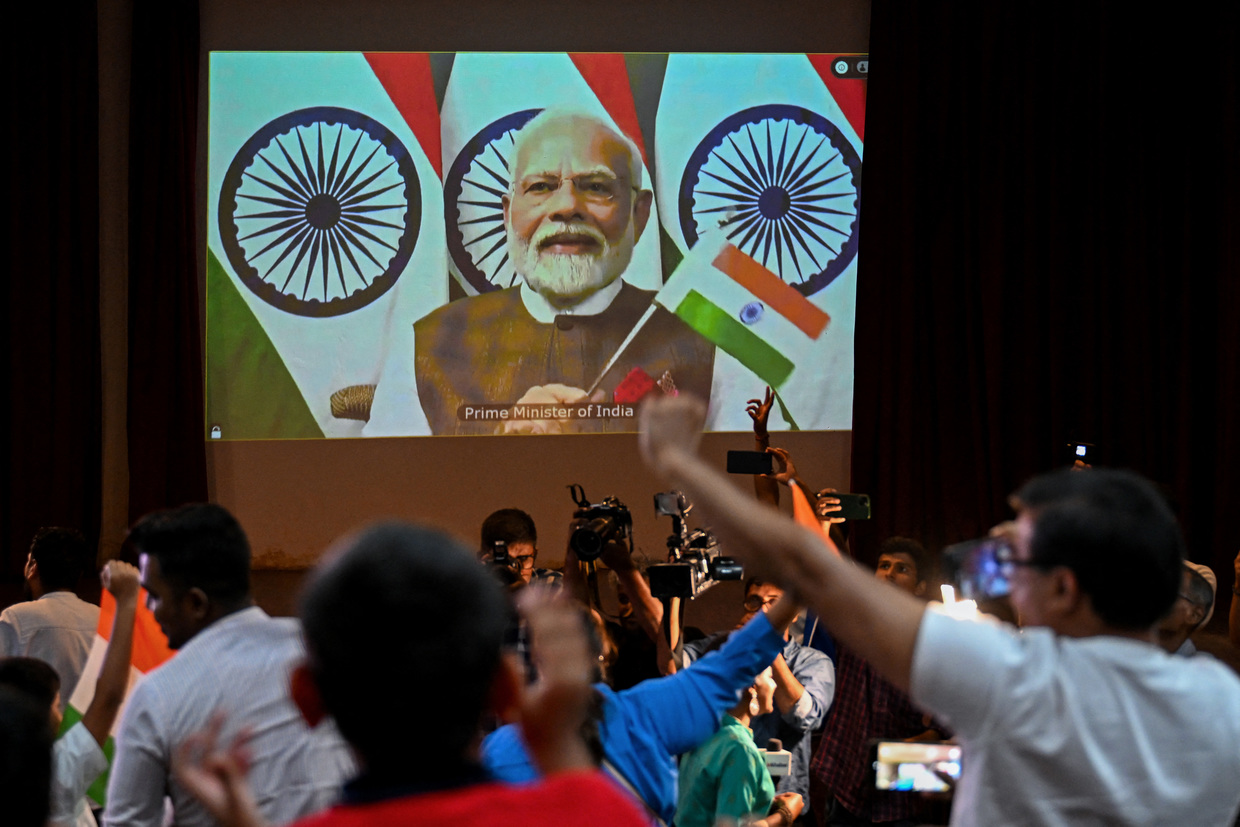
At ISRO’s Telemetry, Tracking and Command (ISTRAC) Network station, where S Smoanath, chairman of the ISRO, and his colleagues monitored the descent and landing, everyone seemed relaxed as they sat with their eyes transfixed on mission computers. At the scheduled hour, 5:44pm Indian time, Vikram, the Indian space agency’s lander, cradling a rover, Pragyan, cruised gracefully, hovered over the lunar soil, peered at the landing site, and descended for a smooth landing. A few minutes later, the rover slid down the ramp for a stroll on the alien terrain.
Somanath made a cryptic announcement: “India is on the Moon” with his colleagues giving a standing ovation to Team Chandrayaan-3.
From the humble beginnings of transporting rockets and satellites on bicycles and bullock carts, ISRO on Wednesday carved a niche for itself among space-faring nations by landing a probe in the South Pole region. In addition, the space agency has joined four others to have achieved a soft landing on the lunar surface, but on shoestring budgets and a fraction of the cost incurred by other agencies.
According to Dr. Mylswamy Annadurai, the former director of ISRO’s Prof U R Rao Satellite Centre, Bengaluru, who led scientists and engineers during the space agency’s first and second outings to the Moon, and later to Mars, the achievement provides ISRO an edge over other space agencies in future missions, in particular ‘Back to the Moon,’ launched by the United States. “This is a historic moment for India from the science and technology point of view as well,” he told RT.
While the United States and European nations were part of the joint lunar probe in 2008, Russia’s request to fly its 30-kg instrument was not accommodated, and it did not make it onboard Chandrayaan-1. “We had 100 kilograms of fuel in excess (onboard the Moon-craft) to support a ten-kg instrument, but Russia felt nothing scientifically significant could be achieved with an instrument weighing only ten kilograms,” he told RT.
Less than a year after its launch, Chandrayaan-1 made history, discovering the elixir of life: Water across vast expanses of the Moon’s polar regions. It also confirmed the presence of iron in the rocky terrain. The tons of water ice could support a lunar outpost and a human colony a couple of decades hence.

Cut to circa 2023.
August 22, a day before the ‘18 minutes of terror’ associated with the planned soft landing of Vikram (named after Space pioneer the late Dr. Vikram Sarabhai), with the rover Pragyan ensconced inside, just like in the unsuccessful Chandrayaan-2 probe, and the aspirations of more than a billion people at stake, Indian space scientists and engineers are confident of occupying the ‘pole position’ with the help of more advanced technologies and a plan B, to attempt a touchdown on August 27.
The landing site: A vast swath measuring four by two-and-a-half kilometers in the South Pole region. Those ‘18 minutes of terror’ commenced around 5:45pm Indian time, with the planned soft landing scheduled just after 6pm. During these nail-biting 18 minutes, the lander’s speed would reduce significantly from about 1.68km a second to almost nil, descending from 30km to a few meters from the lunar soil. It is the sole contender for the ‘pole position’ following the crash of Russia’s Luna-25 two days ago.
Ironically, India and Russia had at first planned to jointly design and launch Chandrayaan-2, after the historic discovery of water by ISRO’s first lunar probe in 2011. Differences arose between their space agencies over the configuration of Chandrayaan-2. While ISRO was keen on a lander and rover, its Russian counterpart felt a lander would suffice, according to Dr. Annadurai.
The upshot: ISRO reconfigured the spacecraft and hoisted it as its first probe to Mars (Mars Orbiter Mission or MOM) in November 2013, while its Russian counterpart teamed up with the Chinese space agency for a voyage to the Moon. The Russian lander, however, was lost during a midcourse correction, he added.
The erstwhile Soviet Union, the US, and China have landed their probes on the Moon, but not in the South Pole region. The South Pole region holds tons of water ice in its caves and is the key to mysteries about the formation of the Moon and Earth. It is also a potential site for lunar outposts and a refueling station for very deep space exploration missions.
ISRO chairman Somanath and his team stayed focused on the arduous task on Wednesday. One of his colleagues, Nilesh Desai, Director of Space Applications Centre (SAC), Ahmedabad, lifted the cloak over plan B: A second attempted landing likely on Sunday, August 27. The tension, obviously, was palpable though Team ISRO exuded confidence in a smooth landing on Wednesday.
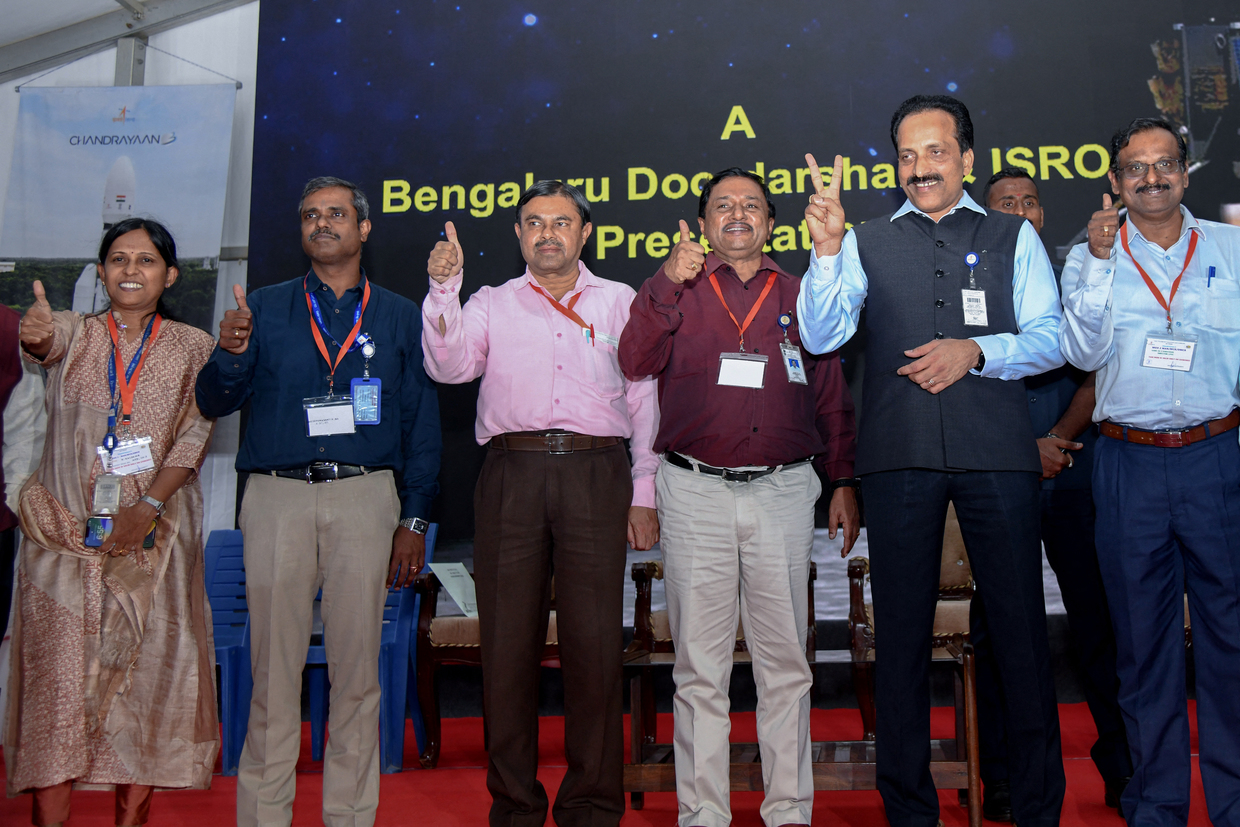
Gopalan Madhavan Nair, who was at the helm when ISRO launched Chandrayaan-1 in 2008, was confident as he told RT, “We will become the player on technologies that facilitate a smooth on Wednesday. Last time itself [Chandrayaan-2, September 2019], we were 99 per cent successful. Most of the objectives were achieved though the lander could not touch down as per our plan.”
Such confidence stems from the fact that the Indian space agency has utilized an upgraded design and advanced technologies, and has built-in many redundancies to avoid the embarrassment of a failed mission as with Chandrayaan-2. “We have signed an MoU with the Japanese Space Agency, JAXA, for joint exploration of the Moon, and with NASA for the Artemis, but other joint investigations will depend on how much respective space agencies could contribute in terms of funds and technologies,” Mr. Nair added.
On the smooth touchdown of Vikram, ISRO plans to roll out the rover and carry out simple in-situ experiments to study the contents of the lunar soil to understand lunar geology, continue the search for water, and map lunar resources.
The future of lunar exploration holds endless possibilities, with several countries, even Israel, announcing plans to head to the Moon – from landers to robotic missions to Artemis, when astronauts could return to the Moon after about five decades.
In addition to pushing the boundaries of science and technology, countries are keen to turn to the Moon to solve the energy crisis, both by mining Helium-3, a fuel for clean energy on Earth, and by deployment of vast solar panels in some areas of the Moon where the Sun never sets. “Some universities in the United States have commenced research projects on utilization of Helium-3 as the fuel for clean energy, and conversion of water ice to either potable water or production of Oxygen and Hydrogen that could be used as fuel for deep space exploration. Those large solar panels could provide energy for various in-situ experiments on lunar soil,” Dr. Annadurai added.
He said the Moon would beckon more nations, big and small, in view of the expanding search for clean energy to support burgeoning industrial activity and expanding urban areas. Besides, the Moon will serve as the gateway to understanding the universe better and to unravel many a secret of the cosmos. And the minerals discovered on the lunar surface could help manufacture a new variety of materials.
Perhaps the Moon would prove an unusual cementing force for numerous international collaborations to pool resources and technological know-how, thus ushering in a new geopolitical age.
